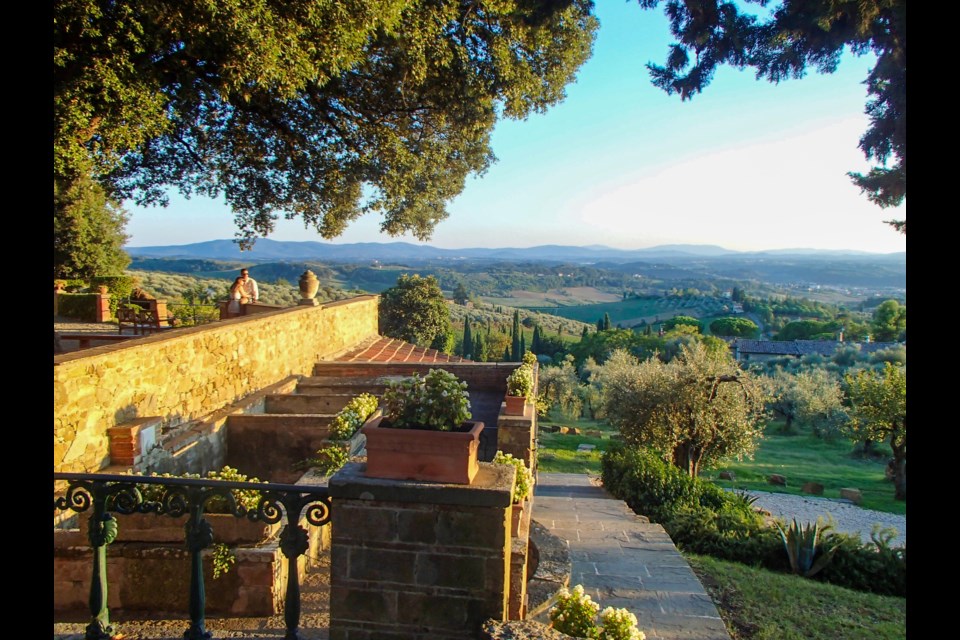Along with the cities of Rome and Venice, the region of Tuscany is one of Italy’s top vacation destinations, replete with landscapes of rolling hills, rows of cypress trees and olive groves, and lush green vineyards. Each of the ten regions of Tuscany has its own unique personality, with historic cities and medieval towns, art-filled museums and cathedrals, Renaissance architecture, beautiful countryside, and great wine and food. Tuscany is regarded as the birthplace of the Italian Renaissance, with many influential artists and scientists including Leonardo da Vinci, Michelangelo, and Galileo Galilei.
Travelers in rural Tuscany have various lodging options, including small hotels and rental villas, often set amid beautiful vineyards or olive groves. Roads are narrow and two-lane most of the way, as they curve their way through the countryside. The best time to visit is during the spring and fall, when the temperatures are comfortable and the crowds are not horrendously large.
Our travel group of six rented a rustic villa in September, in the rolling hills of an off-the-beaten-path hamlet called Lucolena, located near Greve in the Chianti region. Lucolena was named for the ancient castle built there in 1059. Chianti, located halfway between Florence and Siena, is one of the most beautiful parts of Tuscany, with postcard-perfect images of vineyards, interspersed with fields of grain and wooded areas. Stately cypress trees line the laneways of the wineries which abound in the region.
The Chianti zone is Tuscany's largest classified wine region, and produces some eight million cases each year. The dominant grape in the region, Sangiovese, performs better when it receives direct sunlight, which is a benefit of the many hillside vineyards in Tuscany. Chianti, Brunello di Montalcino, and Vino Nobile di Montepulciano wines are primarily made with Sangiovese grapes, whereas the Vernaccia grape is the basis of the white Vernaccia di San Gimignano. Tuscany is also known for a dessert wine called Vin Santo, made from a variety of the region's grapes.
In the 1970s, a new class of wines known in the trade as "Super Tuscans" emerged, based on a Bordeaux blend of Cabernet Sauvignon and Merlot which were not native to the region. These wines are considered of high quality, and command lofty prices.
Here’s a short and incomplete list of must-see places during your tour of Tuscany:
Florence offers Renaissance architecture, excellent museums like Uffizi Gallery and Galleria dell’Accademia, the beautiful Duomo Santa Maria Del Fiore cathedral, and the famous Ponte Vecchio Bridge.
Siena is a classic medieval Tuscan city, built between the 12th and 15th centuries, is a UNESCO cultural heritage site. It is famous for its fan-shaped town centre, Piazza del Campo, which is dominated by its bell tower, the Torre del Mangia.
Pisa has its iconic Leaning Tower, one of Italy’s most recognizable landmarks.
The medieval walled town of San Gimignano is famous for its 14 towers.
Cortona became well-known after the release of the book and movie Under the Tuscan Sun.
Montepulciano is yet another walled city in Tuscany, built on a narrow limestone ridge. It boasts an impressive main square.
Dining is one of the delights of Tuscany, and options are plentiful. A ristorante is a more formal place to eat, with a menu offering multiple courses: antipasti (starter), primo (first course) and secondi (main), plus of course dessert. A trattoria is similar to a ristorante, but a lot more casual. They are typically family-run, and offer traditional home-cooked-style dishes. Historically, the osteria has been the Italian equivalent of an affordable corner pub. However, in more recent years, high-end purveyors of Italian cuisine, with earned Michelin stars, have adopted usage of the term osteria. And of course, basic pizzerias are ubiquitous.
If you are in the mood for fine cuisine and have a thick wallet (remember that you are paying in Euros, worth about a third more than Canadian dollars) here are some Tuscan suggestions, based on personal experience:
Dinner on the patio of Michelin star restaurant Osteria de Passignano, located in Tavarnelle. Osteria di Brolio, located in Gaiole at the Ricasoli Castle and Winery. Osteria 1126, located in the hilltop hamlet of Poggibonsi, is named after the year in which the village was founded. The panoramic views are spectacular, as is the restaurant’s ambience. Sadly, the cuisine did not ascend to the same level on the occasion we visited. Dinner on the terrace at Osteria del Borro, a Michelin star restaurant in the thousand year old village of Valdarno in Arrezo region. Arnolfo Restaurant in Colle di Val d’Elsa, a few miles from San Gimignano and Monteriggioni. It has earned two Michelin stars. The service and attention to detail are outstanding, and every bite tells you it’s (possibly) worth the stratospheric prices.



